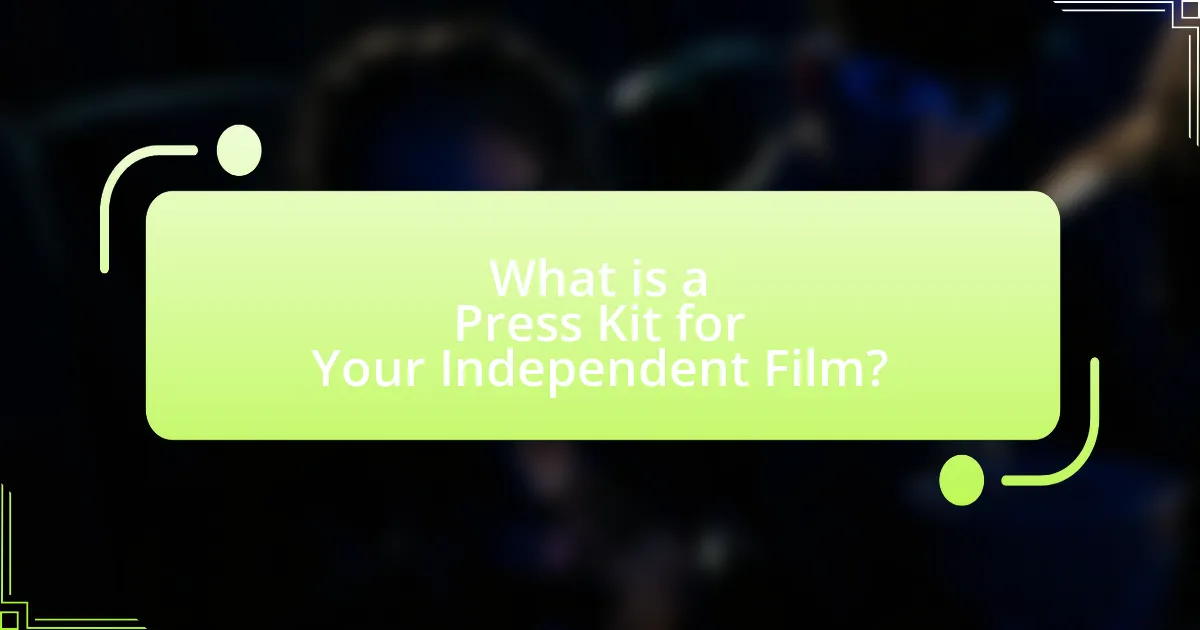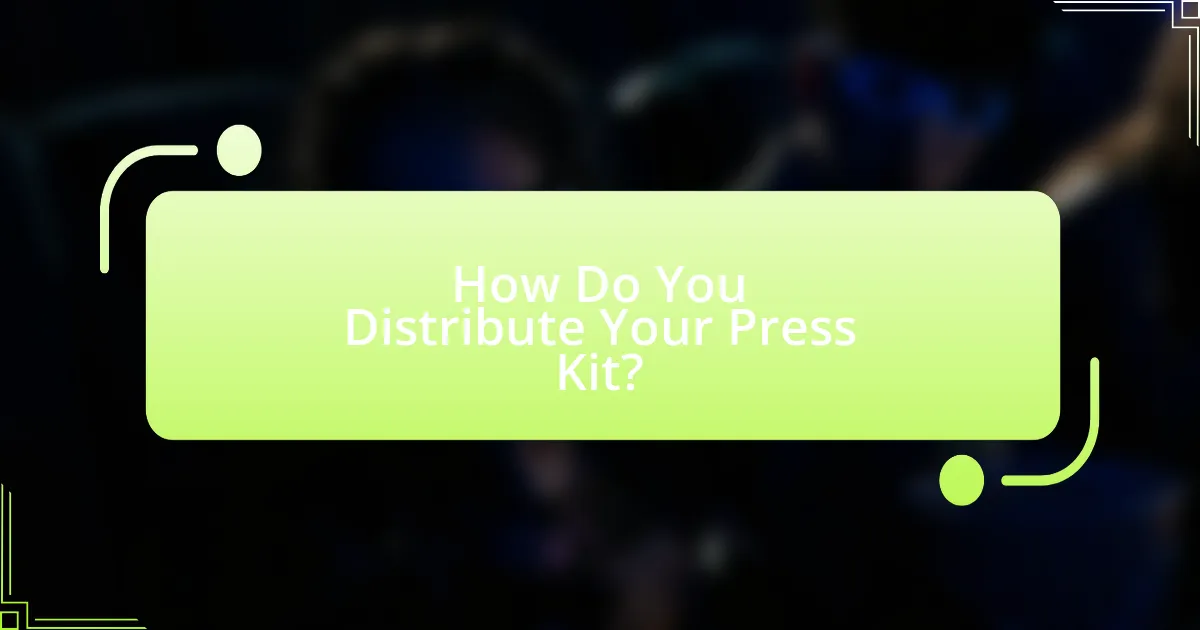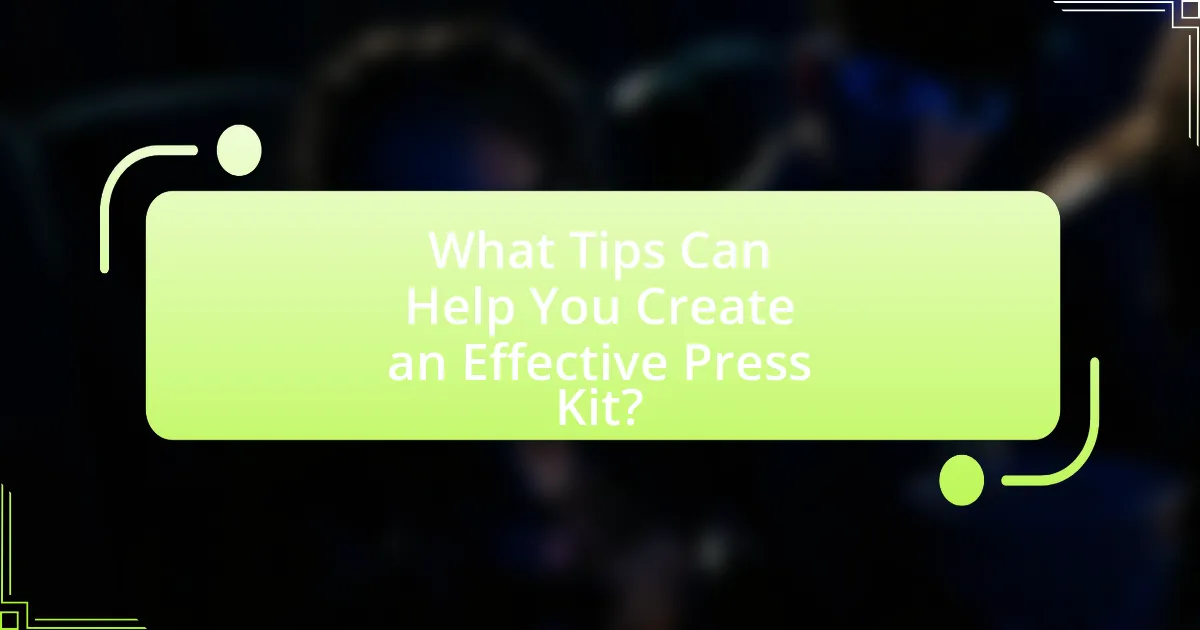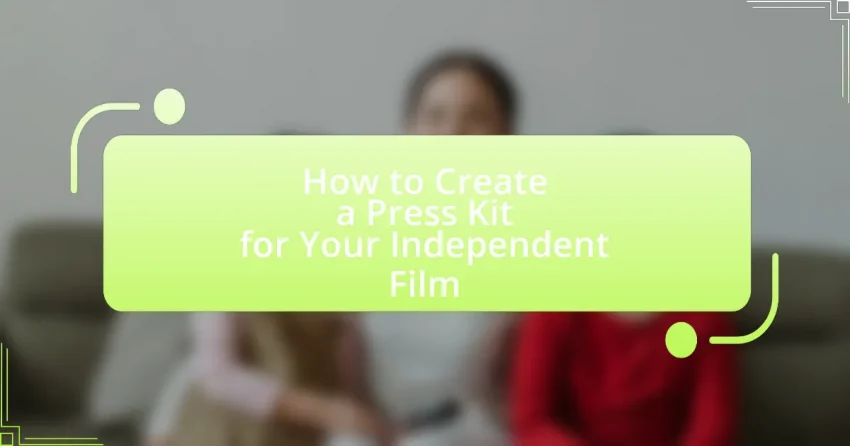A press kit for an independent film is a vital collection of promotional materials that provides essential information to media outlets, potential investors, and audiences. It typically includes a press release, production notes, cast and crew biographies, high-resolution images, and trailers, all aimed at generating interest and coverage for the film. The article outlines the importance of a press kit in enhancing visibility and facilitating media engagement, particularly for independent filmmakers with limited marketing budgets. Key components of an effective press kit, strategies for tailoring content to different audiences, and best practices for distribution and follow-up are also discussed, emphasizing the role of journalists and critics in film promotion.

What is a Press Kit for Your Independent Film?
A press kit for your independent film is a collection of promotional materials designed to provide essential information about the film to media outlets, potential investors, and audiences. This kit typically includes a press release, production notes, cast and crew bios, high-resolution images, and trailers, all aimed at generating interest and coverage for the film. The purpose of a press kit is to facilitate media engagement and enhance visibility, which is crucial for the success of independent films that often lack the marketing budgets of larger productions.
Why is a Press Kit Important for Independent Films?
A press kit is important for independent films because it serves as a comprehensive marketing tool that provides essential information to media outlets, potential investors, and audiences. By including elements such as a synopsis, cast and crew bios, production stills, and contact information, a press kit effectively communicates the film’s unique selling points and artistic vision. This is crucial for independent filmmakers who often lack the budget for extensive marketing campaigns; a well-crafted press kit can generate media coverage and attract attention, increasing the film’s visibility and potential for success. Studies show that films with effective press kits receive significantly more media mentions, which can lead to higher audience turnout and engagement.
What key information should be included in a Press Kit?
A Press Kit for an independent film should include essential information such as a press release, a synopsis of the film, cast and crew biographies, high-resolution images, and contact information for media inquiries. The press release provides a concise overview of the film’s key details, while the synopsis summarizes the plot and themes. Biographies of the cast and crew highlight their backgrounds and previous work, adding credibility. High-resolution images are crucial for media use, showcasing the film’s visual style. Lastly, clear contact information ensures that journalists can easily reach out for further inquiries or interviews.
How does a Press Kit help in film promotion?
A Press Kit helps in film promotion by providing essential information and materials that facilitate media coverage and audience engagement. It typically includes a synopsis, cast and crew bios, high-resolution images, and press releases, which collectively create a comprehensive narrative about the film. This structured presentation allows journalists and influencers to easily access relevant details, increasing the likelihood of articles, reviews, and social media mentions. Research indicates that films with well-prepared Press Kits receive significantly more media attention, enhancing visibility and audience interest, ultimately contributing to box office success.
Who is the Target Audience for Your Press Kit?
The target audience for a press kit for an independent film includes journalists, film critics, bloggers, potential investors, and film festival programmers. These groups seek comprehensive information about the film, such as its storyline, cast, crew, and production details, to facilitate coverage and promotion. For instance, journalists and critics require press kits to write reviews and articles, while festival programmers use them to evaluate films for selection. This audience is crucial for generating buzz and attracting viewership, as they influence public perception and interest in the film.
What roles do journalists and critics play in film promotion?
Journalists and critics play essential roles in film promotion by providing exposure and shaping public perception. Journalists report on films through articles, interviews, and features, which can generate interest and inform potential audiences about upcoming releases. Critics evaluate films, offering reviews that can influence audience decisions and create buzz. For instance, a positive review from a reputable critic can significantly boost a film’s visibility and box office performance, as evidenced by studies showing that films with favorable critical reception tend to perform better commercially.
How can you tailor your Press Kit for different audiences?
To tailor your Press Kit for different audiences, customize the content and presentation based on the specific interests and needs of each audience segment. For example, when targeting film critics, emphasize technical aspects such as cinematography and direction, while for potential investors, focus on financial projections and market potential. Research shows that personalized communication increases engagement; a study by the Direct Marketing Association found that targeted messages can improve response rates by up to 50%. By aligning your Press Kit with the priorities of each audience, you enhance its effectiveness and relevance.

What Are the Essential Components of a Press Kit?
The essential components of a press kit include a press release, a company or project overview, biographies of key team members, high-resolution images, and contact information. A press release provides a concise summary of the film, while the overview gives context about the project. Biographies highlight the expertise of the team, and high-resolution images are crucial for media use. Contact information ensures that journalists can reach out for further inquiries. These elements collectively facilitate effective communication and promote the film to the media.
What materials should be included in your Press Kit?
A press kit for an independent film should include a variety of materials to effectively communicate the film’s essence and attract media attention. Essential components are a press release, which outlines the film’s synopsis, cast, crew, and production details; high-resolution images, including stills from the film and behind-the-scenes shots; a fact sheet that provides key information such as release date, running time, and festival screenings; biographies of the main cast and crew to highlight their backgrounds and achievements; and contact information for press inquiries. Including a trailer or link to a digital screener can also enhance the kit’s appeal. These materials collectively provide a comprehensive overview of the film, making it easier for journalists and media outlets to cover the project effectively.
How do you create an engaging press release?
To create an engaging press release, focus on crafting a compelling headline that captures attention and summarizes the key message. An effective press release should include a strong lead paragraph that answers the who, what, when, where, and why of the news, followed by supporting details that provide context and significance. Incorporating quotes from key stakeholders, such as the film’s director or lead actor, adds a personal touch and credibility. Additionally, using clear and concise language, along with relevant statistics or facts about the film’s production or audience engagement, enhances the release’s impact. For example, a press release for an independent film might highlight its premiere date, festival selections, and audience reception metrics to demonstrate its relevance and appeal.
What is the significance of including cast and crew bios?
Including cast and crew bios is significant because they provide essential context about the individuals involved in a film, enhancing its credibility and appeal. These bios highlight the experience, skills, and previous works of the cast and crew, which can attract interest from potential investors, distributors, and audiences. For instance, a well-known actor’s involvement can increase a film’s marketability, while a skilled director’s background can assure stakeholders of the project’s quality. Furthermore, bios can foster a connection between the audience and the film, as viewers often appreciate knowing the people behind the production.
How can visuals enhance your Press Kit?
Visuals can significantly enhance your Press Kit by making it more engaging and informative. High-quality images, infographics, and videos can capture attention and convey your film’s themes and style effectively. For instance, a study by the Visual Teaching Alliance found that visuals can increase information retention by up to 65%, demonstrating their power in communication. Additionally, including behind-the-scenes photos or character sketches can provide context and deepen the audience’s connection to the film, making the Press Kit not only a promotional tool but also a storytelling medium.
What types of images should you include?
Include high-quality stills from the film, behind-the-scenes images, and promotional graphics in your press kit. High-quality stills capture key moments and characters, providing visual context for the film’s narrative and style. Behind-the-scenes images offer insight into the filmmaking process, showcasing the crew and the environment, which can engage the audience’s interest. Promotional graphics, such as posters or logos, help establish the film’s branding and can be used for marketing purposes. These types of images collectively enhance the press kit’s appeal and effectiveness in attracting media attention and audience interest.
How can you effectively use video content in your Press Kit?
To effectively use video content in your Press Kit, include a high-quality trailer that showcases the film’s key themes and visual style. This trailer should be concise, ideally under two minutes, to maintain viewer engagement while highlighting the film’s unique selling points. Additionally, consider incorporating behind-the-scenes footage or interviews with the cast and crew to provide context and deepen the audience’s connection to the project. Research indicates that video content can increase viewer retention by up to 80%, making it a powerful tool for capturing interest and conveying the film’s narrative effectively.

How Do You Distribute Your Press Kit?
To distribute your press kit, utilize email, online platforms, and physical copies. Email is the most direct method; send your press kit to journalists, bloggers, and influencers who cover film-related content. Online platforms such as your film’s website or social media channels can host downloadable versions of your press kit, making it accessible to a wider audience. Additionally, consider printing physical copies to distribute at film festivals, screenings, or industry events, ensuring that key stakeholders have tangible access to your materials. This multi-channel approach increases the likelihood of your press kit reaching the intended audience effectively.
What are the best practices for sending out your Press Kit?
The best practices for sending out your Press Kit include personalizing your outreach, targeting the right media contacts, and ensuring your materials are easily accessible. Personalization increases engagement; addressing journalists by name and referencing their previous work can enhance the likelihood of a response. Targeting the right media contacts involves researching journalists who cover topics relevant to your film, which improves the chances of your Press Kit being noticed. Additionally, providing digital access to your Press Kit through a well-organized online platform or a downloadable link ensures that journalists can easily access and share your materials, increasing visibility. These practices are supported by industry standards that emphasize the importance of tailored communication and accessibility in media relations.
How can you leverage social media for distribution?
You can leverage social media for distribution by creating targeted content that engages your audience and encourages sharing. Social media platforms like Facebook, Instagram, and Twitter allow filmmakers to reach specific demographics, increasing visibility for their independent films. For instance, a study by the Pew Research Center indicates that 69% of adults in the U.S. use Facebook, making it a powerful tool for reaching potential viewers. Additionally, utilizing features such as hashtags, stories, and live sessions can enhance audience interaction and promote film-related events or releases effectively.
What platforms are most effective for sharing your Press Kit?
The most effective platforms for sharing your Press Kit include your official website, social media channels, and online press release distribution services. Your official website serves as a central hub where journalists can easily access your Press Kit, ensuring that all relevant information is organized and readily available. Social media channels like Facebook, Twitter, and Instagram allow for direct engagement with your audience and can amplify the reach of your Press Kit through shares and posts. Online press release distribution services, such as PR Newswire or Business Wire, provide a broader reach by distributing your Press Kit to various media outlets and journalists, increasing the likelihood of coverage. These platforms collectively enhance visibility and accessibility, making it easier for media professionals to find and utilize your Press Kit.
How can you follow up after distributing your Press Kit?
To follow up after distributing your Press Kit, send a personalized email to each recipient within one week of distribution. This email should express gratitude for their time and interest, while also inviting any questions or requests for additional information. Research indicates that timely follow-ups can increase engagement rates by up to 30%, making it a crucial step in maintaining communication with media contacts.
What strategies can you use to engage with journalists post-distribution?
To engage with journalists post-distribution, follow up with personalized emails that reference their previous work and express appreciation for their coverage. This approach fosters a relationship by showing genuine interest in their reporting. Additionally, share exclusive content, such as behind-the-scenes footage or interviews with cast and crew, to provide added value and encourage further engagement. According to a study by the Public Relations Society of America, personalized communication increases the likelihood of journalists responding positively, reinforcing the effectiveness of tailored outreach.
How do you measure the effectiveness of your Press Kit outreach?
To measure the effectiveness of Press Kit outreach, track metrics such as media coverage, engagement rates, and feedback from journalists. Analyzing the number of articles published, social media shares, and direct inquiries generated from the Press Kit provides concrete evidence of its impact. For instance, a study by the Public Relations Society of America indicates that effective press outreach can lead to a 30% increase in media mentions, demonstrating the correlation between outreach efforts and visibility.

What Tips Can Help You Create an Effective Press Kit?
To create an effective press kit for your independent film, include essential elements such as a compelling press release, high-quality images, and a detailed synopsis. A well-crafted press release should highlight the film’s unique aspects and key personnel, while high-resolution images should showcase pivotal scenes and cast members to attract media attention. Additionally, a concise synopsis provides a clear overview of the film’s plot and themes, making it easier for journalists to understand its essence. According to industry standards, a press kit should also contain bios of the director and main cast, production notes, and contact information for further inquiries, ensuring that all necessary information is readily available for media coverage.
What common mistakes should you avoid when creating a Press Kit?
Common mistakes to avoid when creating a Press Kit include providing excessive information, neglecting to tailor content for the target audience, and failing to include high-quality visuals. Excessive information can overwhelm journalists, making it difficult for them to extract key details. Tailoring content ensures that the Press Kit resonates with the specific interests of the audience, increasing the likelihood of media coverage. High-quality visuals, such as professional photos and graphics, enhance the appeal of the Press Kit and can significantly impact a journalist’s decision to feature the film.
How can you ensure your Press Kit stands out from the competition?
To ensure your Press Kit stands out from the competition, focus on creating a visually appealing and informative design that highlights unique aspects of your independent film. Incorporate high-quality images, compelling storytelling, and clear, concise information about the film’s themes, cast, and crew. Research shows that visually engaging materials increase retention and interest; for instance, a study by the Wharton School found that people remember 65% of visual content three days later, compared to only 10% of text. Additionally, tailor your Press Kit to the specific interests of your target media outlets, ensuring that it addresses their audience’s preferences and needs.
What are some best practices for maintaining your Press Kit?
To maintain your Press Kit effectively, regularly update its content to reflect the latest information about your film, including new accolades, screenings, and press coverage. This ensures that journalists and industry professionals have access to the most current and relevant details. Additionally, organize the Press Kit in a user-friendly format, making it easy to navigate and find specific information quickly. Regularly review and remove outdated materials to keep the kit concise and focused. Lastly, ensure that all digital assets, such as images and videos, are high-quality and accessible, as this enhances the professionalism of your Press Kit and increases the likelihood of media coverage.
